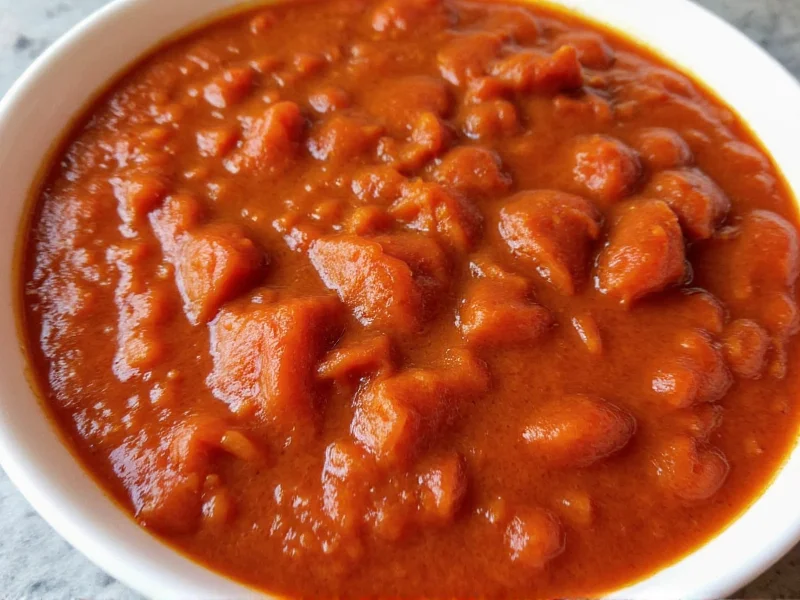Understanding what chamoy sauce is requires exploring its unique fusion of flavors and cultural journey. This versatile condiment has become integral to Mexican street food culture, transforming ordinary snacks into extraordinary culinary experiences. Whether drizzled over fresh fruit, used as a dipping sauce, or incorporated into cocktails, chamoy's distinctive taste profile makes it a beloved staple.
Historical Origins of Chamoy Sauce
The story of chamoy sauce begins not in Mexico, but with Chinese immigrants who brought preserved fruits to the Philippines. When Filipino traders arrived in Mexico during the Manila-Acapulco Galleon trade (1565-1815), they introduced these preserved fruits to Mexican cuisine. Mexican cooks adapted the Chinese li hing mui (dried, salted plums) by incorporating local ingredients like chilies, creating what we now know as chamoy.
This cultural fusion represents one of many examples of how global trade routes influenced Mexican culinary traditions. The name "chamoy" itself likely derives from the Chinese term "suan mei" (sour fruit), transformed through generations of adaptation in Mexican kitchens.
Ingredients and Production Process
Authentic chamoy sauce ingredients typically include:
| Core Ingredients | Function | Common Variations |
|---|---|---|
| Dried plums, apricots, or mangoes | Base fruit component | Fresh mango or tamarind pulp |
| Chili powder (typically árbol or de árbol) | Provides heat | Chipotle, guajillo, or arbol peppers |
| Vinegar or lime juice | Acid component | White vinegar, apple cider vinegar |
| Salt | Preservative and flavor enhancer | Sea salt, Himalayan pink salt |
| Sugar | Sweetness balance | Piloncillo, honey, or agave syrup |
The traditional production process involves rehydrating dried fruits, then simmering them with vinegar, chilies, and salt to create a thick, flavorful sauce. Commercial versions often include additional preservatives and thickeners to extend shelf life. Understanding what is chamoy sauce made of reveals why homemade versions typically offer more complex flavors than mass-produced alternatives.
Flavor Profile and Characteristics
Chamoy sauce delivers a remarkable balance of five fundamental tastes:
- Sweet from fruit sugars and added sweeteners
- Sour from vinegar or citrus components
- Salty from the preservation process
- Spicy from chili peppers
- Umami from fermented elements
This complex flavor profile distinguishes chamoy from similar sauces like tajín (which is dry) or straight tamarind sauce. The difference between chamoy and tamarind sauce lies in chamoy's incorporation of multiple fruits, chilies, and the pickling process that creates its distinctive tang.
Common Culinary Applications
Chamoy sauce serves as both a condiment and ingredient in numerous Mexican dishes. Knowing how to use chamoy sauce in recipes expands your culinary possibilities significantly:
- Fruit preparations - Drizzled over fresh mango, pineapple, or watermelon with chili powder
- Street snacks - Essential for chamoyadas (frozen drinks) and chamoyadas raspadas (shaved ice)
- Snack enhancement - Coating for dried mango strips, gummy candies, and cucumber slices
- Cocktail ingredient - Used in micheladas and other savory beverages
- Marinades - Combined with lime for meats, particularly chicken and pork
When exploring where to buy chamoy sauce near me, consumers typically find it in Latin American grocery stores, often in squeeze bottles or as a coating for pre-packaged snacks. Major brands like Don Pedro, Tajín, and Mi Rancho offer reliable commercial options.
Variations Across Mexico
Regional variations of chamoy sauce reflect local preferences and available ingredients:
- Northern Mexico - Typically spicier with more árbol chili content
- Central Mexico - Balanced sweetness with moderate heat
- Coastal regions - Often incorporates tropical fruits like mango or tamarind
- Homemade versions - Vary based on family recipes passed through generations
These regional differences explain why authentic chamoy sauce recipe ingredients might vary significantly depending on location. Some versions incorporate additional elements like apricot, plum, or even hibiscus for color and flavor complexity.
Selecting and Storing Chamoy Sauce
When choosing chamoy sauce, consider these factors:
- Texture - Should be smooth but not watery; thicker versions work better for dipping
- Color - Vibrant red to deep purple indicates quality fruit content
- Ingredients list - Fewer additives typically indicate higher quality
- Heat level - Ranges from mild to extremely spicy depending on brand
Proper storage extends chamoy sauce's shelf life significantly. Commercial versions typically remain good for 6-12 months unopened. Once opened, refrigerate and use within 2-3 months. Homemade chamoy sauce lasts approximately 1 month when properly stored in airtight containers in the refrigerator.
Cultural Significance in Mexican Cuisine
Chamoy represents more than just a condiment—it embodies Mexico's history of cultural fusion. The sauce's journey from Chinese preserved fruits to Mexican street food staple illustrates how culinary traditions evolve through migration and trade. Today, chamoy appears at festivals, markets, and family gatherings throughout Mexico.
Understanding traditional Mexican chamoy sauce history helps appreciate why this sauce has become so deeply embedded in Mexican food culture. It's not merely a flavoring but a symbol of cultural adaptation and creativity.
Nutritional Considerations
While delicious, chamoy sauce contains significant sugar and sodium due to its preservation process. A typical serving (1 tablespoon) contains:
- Approximately 20-30 calories
- 4-6 grams of sugar
- 150-250mg of sodium
- Minimal fat and protein
Those monitoring their sugar or sodium intake should use chamoy sauce in moderation. The nutritional information for chamoy sauce varies between brands, with artisanal versions often containing less added sugar than commercial mass-produced options.











 浙公网安备
33010002000092号
浙公网安备
33010002000092号 浙B2-20120091-4
浙B2-20120091-4